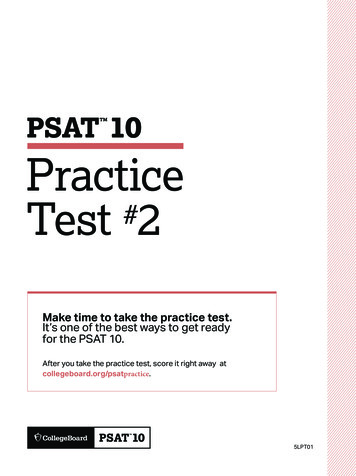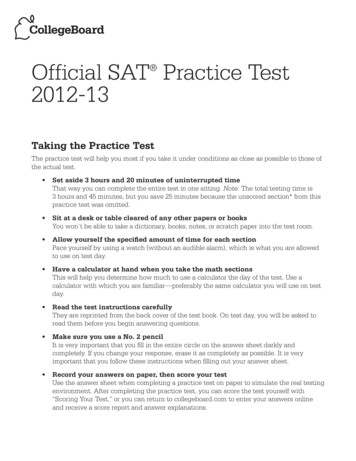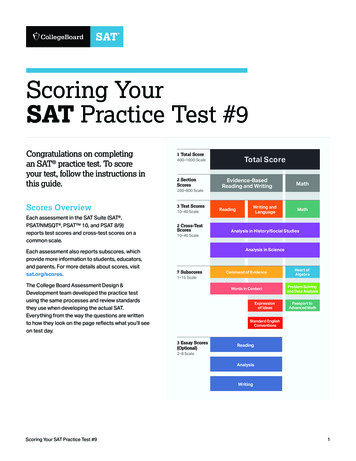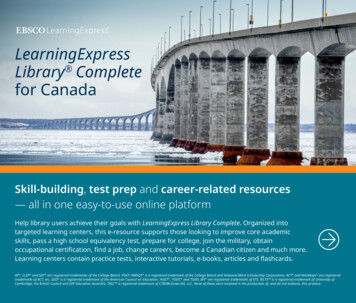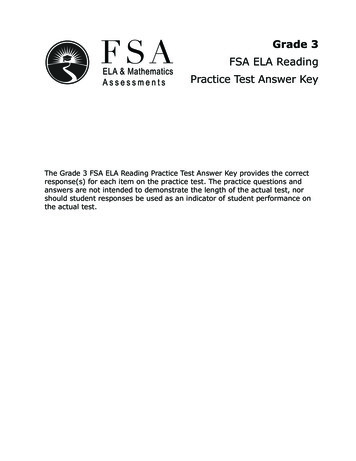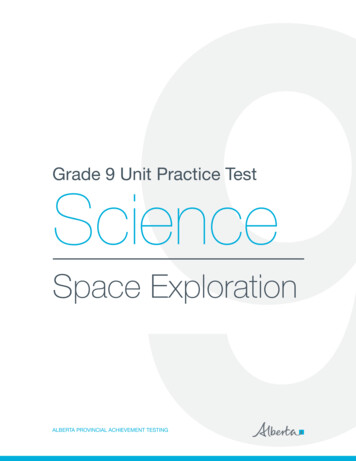
Transcription
Grade 9 Unit Practice TestScienceSpace ExplorationALBERTA PROVINCIAL ACHIEVEMENT TESTING
Copyright 2020, the Crown in Right of Alberta, as represented by theMinister of Education, Alberta Education, Provincial Assessment Sector,44 Capital Boulevard, 10044 108 Street NW, Edmonton, Alberta T5J 5E6,and its licensors. All rights reserved.Special permission is granted to Alberta educators only to reproduce,for educational purposes and on a non-profit basis, parts of thisdocument that do not contain excerpted material.
1.Which of the following statements describes the current model of the solar system?A.B.C.D.The Sun orbits planets and the Moon orbits Earth.The Sun orbits planets and Earth orbits the Moon.Planets orbit the Sun and the Moon orbits Earth.Planets orbit the Sun and Earth orbits the Moon.Use the following information to answer question 2.From a specific point, a star can be found using the coordinates below.Altitude 32 Azimuth 45 Peggy wants to find this star in the night sky.2. To physically locate the star, Peggy must face north, turnhorizon at an angle ofii.The statement above is completed by the information in rowRowiiiA.clockwise 45 32 B.counterclockwise 45 32 C.clockwise 32 45 D.counterclockwise 32 45 1i, and look above the
Use the following information to answer numerical-response question 1.Parts of the Universe1234EarthGalaxySolar systemSunNumerical Response1.List the parts of the universe above in order from the part with the smallest diameter to thepart with the largest diameter.SmallestdiameterLargestdiameter(Record all four digits of your answer.)2
Use the following information to answer question 3.The Orbits of Four Satellites3. Which satellite in the diagram above can transmit signals over the greatest area of Earth’ssurface?A.B.C.D.4.Satellite WSatellite XSatellite YSatellite ZAstronomers conduct spectral analysis toA.B.C.D.see images in space that are not distorted by Earth’s atmosphereobserve celestial bodies that were previously invisiblemap the location of celestial bodies in the skydetermine the composition of stars3
Use the following information to answer question 5.The diagram below shows Earth in various positions around the Sun in relation to anunknown star.5.The best baseline to determine the distance between the unknown star and the Sun shownabove will be established when Earth is in positions W andA.B.C.D.6.VXYZThe Hubble Space Telescope produces clearer images than similar telescopes that are usedon Earth becauseA.B.C.D.the Hubble Space Telescope is in orbit at a distance of about 550 km from Earththe Hubble Space Telescope is closer to the stars that it is viewingthere is no interference from Earth’s atmosphere in spacethere is no air pressure in space4
Use the following information to answer questions 7 and 8.Sunspots are associated with solar flares and coronal mass ejections (CMEs). The numberof sunspots alternates between periods of high numbers (solar maximum) and periods oflow numbers (solar minimum).—SILSO data, Royal Observatory of Belgium, Brussels7. Based on the information above, the number of sunspots that are expected to be observed in2006 isA.B.C.D.8.15354050Based on the information above, the manipulated (independent) variable is theA.B.C.D.yearnumber of sunspots observedsolar flares and coronal mass ejectionstime between solar maximums and solar minimums5
9. Which of the following technologies provides the least information about celestial bodiesin our solar system?A.B.C.D.TelescopeRemote sensingSpectral analysisGlobal positioning systemUse the following information to answer question 10.10. When compared with supergiants, white dwarfs areA.B.C.D.brighter and colderbrighter and hotterdimmer and colderdimmer and hotter6
Use the following information to answer question 11.A Student Viewing a Hanging Sphere11. What is the student in the illustration above most likely trying to determine?A.B.C.D.Diameter of the sphereDistance to the sphereAzimuth of the sphereAltitude of the sphere7
Use the following information to answer question 12.Information About JupiterLength of year 142 Earth monthsLength of day 10 Earth hours12.When compared to the size of Earth’s orbit, Jupiter’s orbit isicompared to Earth’s spin on its axis, Jupiter’s spin on its axis isThe statement above is completed by the information in erD.smallerfaster8ii, and when.
Use the following information to answer numerical-response question 2.Over time, several technologies have been developed to study and explore space.Technologies1Rockets and space shuttles2Radio telescope3ProbeNumerical Response2.Match each of the technologies numbered above with its description given below. (Use eachnumber only once.)Designed to detectlow-frequency energy from space(Record in the first column)Designed to travel tocelestial bodies beyond the Moon(Record in the second column)Designed to transportequipment to the International Space Station(Record in the third column)(Record all three digits of your answer.)9
Use the following information to answer question 13.The year 2050 is the target date for the creation of a base on the Moon.13.Which two speakers above ask questions that reflect an economic perspective?A.B.C.D.Speakers I and IIISpeakers I and IVSpeakers II and IIISpeakers II and IV10
Use the following information to answer question 14.Space junk is debris from artificial objects that orbit Earth.14.From the perspective of an astronaut travelling in space, the most significant concern withspace junk is the threat ofA.B.C.D.15.collisions with the Sun causing solar flaresdamage to a spacecraft or the International Space Stationcollisions with Mars damaging space probes on that planetre-entry into Earth’s atmosphere causing craters in Earth’s crustWhich of the following diagrams represents one year on Earth?11
16.The primary advantage of placing an optical telescope in space, rather than on Earth’ssurface, is that itA.B.C.D.enables the telescope to be maintained at cold temperaturesprevents distorted images that result from light and air pollutiondecreases the distance from the telescope to the celestial objects being studieddecreases the telescope’s exposure to damaging electromagnetic radiation in theatmosphere17. Which of the following measurements could be calculated by using the parallax technique?A.B.C.D.Brightness of a celestial bodyTemperature of a celestial bodyDistance between two celestial bodiesSpeed at which a celestial body is travelling12
Use the following information to answer question 18.Some Instruments Used by Ancient Astronomers18.Which pair of instruments described above functions primarily because of the rotation ofEarth on its axis?A.B.C.D.The sundial and the merkhetThe sundial and the astrolabeThe quadrant and the merkhetThe quadrant and the astrolabe13
Science 9 – Practice Test 2019 Space Exploration KeyQuestion 15B16B17C18A
Science 9 - Practice Test 2019 Space Exploration Key Question # Key 1 C 2 A NR1 1432 3 C 4 D 5 C 6 C 7 A 8 A 9 D 10 D 11 D 12 B NR2 231 13 A 14 B 15 B 16 B 17 C 18 A. Title: Science 9 Unit Practice Test - Space Exploration Author: Government of Alberta - Alberta Education Subject: Science 9 Keywords:

